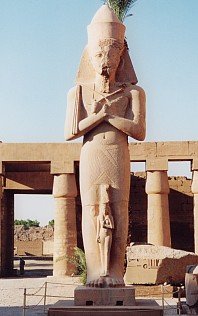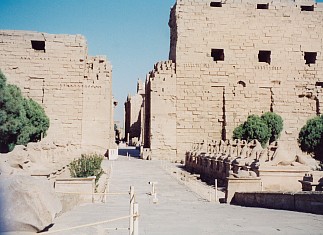




 |
Egyptianholiday |
  |
 |
|
| Dendera | Nile | Valley of The Kings | Karnak | Abu Simbel | Hieroglyphs | Cartouches | Luxor temple | Hatshepsut | British Musuem | Changing Gallery | Edfu | Philae | Colossi | Kom Ombo | Mummified Animals | Sphinx | Pyramids| Home | About Egyptianholiday | |||
 |
Welcome to the Temple of Karnak Dedicated to the God Amun-Ra, Karnak is the largest temple city ever built , one of the greatest sites in Egypt, it was built over 2000 years ago. Karnak was known to ancient Egyptians as Ipet-isut ; "The Most Select (or Sacred) of Places".As the largest temple complex ever built by man, it comprises three main temples(Mut, Montu and Amun), smaller enclosed temples, a sacred lake and a variety of outer temples which are located approximately three kilometers north of Luxor. The sheer size of the complex around 100 hectares took around thirteen hundred years to develop and construct. Each pharaoh that commissioned work at Karnak left their mark through statues, architecture and reliefs even if this resulted deconstruction and disorder. Over the course of time the site at Karnak has been expanded outwards from just behind the sanctuary of Amun, this means that the middle of the complex is the oldest part of the site.Mut, Montu and Amun Temples, surrounded by enormous brick walls are situated as follows; The Temple of Amun, is in the center of the complex, The Temple of Montu is to the north of the Temple of Amun, and Temple of Mut is to the south. The main entrance to the temple is that on the west side. This entrance used to be a quay built by Rameses II. This quay was used to access the river Nile (via a canal) to unload/load boats carrying statues of the gods during festivals, this is where the cult statue of Amun would leave on its weekly tour of the west bank temples. There are names of kings on the quay each recording the levels of inundations during their reigns.FIRST PYLON As can be seen from the photograph above, ram-headed sphinxes line the path leading towards the towering front of the entrance.In their paws, the sphinxes house a statue of Rameses II. Furthermore the sphinxes have a body of a lion and the head of a ram (a symbol of the god Amun). The pylons were built by different pharaohs, each attempting to overshadow its predecessor. The first pylon is unfinished but the Second Pylon is that of the temple of Amun (built by Ramesses II but restored and enlarged by the Ptolemies). |
||
SECOND PYLON/HYPOSTYLE HALL The Second pylon leads into a Hypostyle Hall, initiated by Amenhotep III, continued by Seti I and completed by his son Ramesses II.This is reflected in the varying reliefs contained within the hall. In its full splendour the hall was painted with natural earth tones, had an impressive 82 feet high ceiling supported by 12 central papyrus columns and contained 122 smaller outer columns. Even the outer walls of the hall are of interest and contain reliefs showing battle scenes, of which the hieroglyphic texts showing the Hittite king and Ramesses II signing a peace treaty in the twenty-first year of Ramesses reign is historically significant as it is the first evidence found for a formal diplomatic agreement. TRANSVERSE HALL Behind the rear wall of the Hypostyle Hall is the Transverse Hall which has the earliest remains of the site at Karnak.The Transverse Hall is located next to a partially reconstructed Third Pylon (built by Amenhotep III) which leads into a narrow court that used to contain obelisks. One of the remaining obelisks is that erected by Tuthmosis I, at is 70 feet (21.3m) in height it weighs around 143 tons. With the exception of two Pharaoh who added their own inscriptions, on either side of the original, this obelisk was left in its original state. HATSHEPSUT OBELISK Nearby is the only remaining Obelisk of Hatshepsut; 97 feet (29.6m) tall and weighing around 320 tons. Interestingly with the exception of the Lateran obelisk (101 feet (30.7m) high) in Rome, Hatshepsut's obelisk is the tallest standing obelisk. This obelisk is one of 2 red granite obelisks built by Hatshepsut; the remains of the other lie near the sacred lake. Hatshepsut's obelisks were built from a single piece of granite and lined with gold. As stated on the page about Hatshepsut and her temple the obelisks are dedicated to her father Amun; an inherent part of her claim to the throne.The inscription on the obelisk reads, O ye people who see this monument in years to come and speak of that which I have made, Tuthmosis III was Hatshepsut's successor and bitter (find out why by clicking on the Hatshepsut link at the top of the page)nephew/stepson. In vengeance Tuthmosis III built a high wall around Hatshepsut's obelisk so that only the top third of the obelisk was visible. His motive for doing this rather than destroying the obelisk is unclear as is the cause of Hatshepsut's death.
|
|||
HOLY OF HOLIES/SANCTUARY Further down lies the site of many sanctuaries "Holy of Holies" or "sanctuary". The first shrine built here by Hatshepsut was replaced by Tuthmose III, with the exception of the rooms surrounding the shrine. The present day sanctuary was built by the brother of Alexander the Great, Philip Arrhidaeus (323-316 BC) who was the King of Macedonia but even this contains blocks from the Tuthmosis sanctuary and still has inscriptions from the sanctuary constructed by Tuthmose III. The present pillars contained in the area in front of the sanctuary (called pillars of the north and south) were also erected by Tuthmose III. The northern pillar displays the emblem of Lower Egypt, the papyrus, and the southern one is the lily (or Lotus) of Upper Egypt. The sanctuary even has a contribution from Tutankhamen (the boy-king) placed in the passageway; a statue pair representing Amun and Amunet, and many believe that is shows the face of Tutankhamen. |
|||
OTHER SITES OF INTERESTAs the site at Karnak extends over a mile or so, there are many things to explore including the following:
Above Left: The statue of Pinudjem priest of Amun-Ra housed at Karnak |
|||
|
SEVENTH THROUGH TO TENTH PYLON including some of their landmarks:
|
||